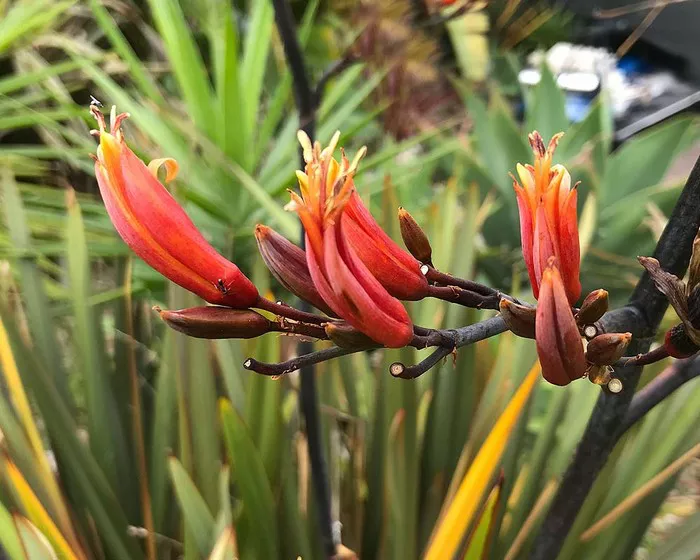Phormium, commonly known as New Zealand flax, is a genus of perennial plants native to New Zealand and Norfolk Island. These striking plants are renowned for their ornamental foliage, but their flowers also hold a unique allure. In this article, we delve into the anatomy, variations, significance, and cultivation of Phormium flowers, unraveling their enigmatic beauty.
Anatomy of Phormium Flowers
Phormium flowers possess a distinctive structure characterized by intricate details and vibrant colors. Typically, these flowers consist of six tepals arranged in two whorls, reminiscent of lilies and amaryllis. The tepals, which are petal-like structures, can vary in shape and size depending on the species and cultivar.
One of the most notable features of Phormium flowers is their long, tubular form, which gives them a graceful appearance. These tubular flowers often measure several inches in length and exhibit hues ranging from fiery reds and oranges to delicate pinks and yellows. Additionally, some Phormium species produce flowers with contrasting markings or intricate patterns, adding to their visual appeal.
The reproductive organs of Phormium flowers include stamens and pistils, essential for pollination and seed production. Stamens, the male reproductive organs, typically comprise six filaments topped with pollen-producing anthers. The pistil, the female reproductive organ, consists of a stigma, style, and ovary, where fertilization occurs.
Variations in Phormium Flowers
Phormium flowers display remarkable diversity in color, shape, and size, reflecting the extensive range of species and cultivars within the genus. While some varieties boast vibrant, solid-colored blooms, others feature bi-colored or variegated flowers with captivating patterns.
Among the myriad of Phormium cultivars, several stand out for their exceptional floral displays. For instance, Phormium ‘Yellow Wave’ showcases striking yellow flowers with subtle green undertones, complementing its variegated foliage. Conversely, Phormium ‘Sundowner’ boasts rich reddish-pink flowers that contrast beautifully against its bronze-purple leaves.
In addition to color variations, Phormium flowers exhibit differences in form and structure. Some species produce compact clusters of flowers, while others feature more elongated inflorescences that gracefully arch above the foliage. These variations contribute to the overall aesthetic appeal of Phormium plants, offering endless possibilities for landscape design and garden composition.
Significance of Phormium Flowers
While Phormium flowers may not be as prominent as their foliage, they play a crucial role in the plant’s life cycle and ecological interactions. As with many flowering plants, Phormium relies on pollinators, such as bees, butterflies, and birds, to facilitate pollination and ensure reproductive success.
The tubular shape of Phormium flowers is particularly well-suited for attracting specific pollinators, including long-tongued insects and nectar-feeding birds. These floral adaptations help optimize the plant’s reproductive efficiency and enhance its ecological relationships within its native habitat.
Furthermore, Phormium flowers contribute to the aesthetic appeal of gardens and landscapes, providing bursts of color and texture amidst the foliage. Whether planted en masse or used as focal points, these flowers add visual interest and seasonal variation to outdoor spaces, captivating the senses and inspiring admiration.
Cultivating Phormium Flowers
Cultivating Phormium flowers can be a rewarding endeavor, offering gardeners the opportunity to appreciate their beauty up close and contribute to their conservation. Here are some key considerations for successfully growing Phormium plants and encouraging flowering:
1. Site Selection: Choose a well-drained location with full to partial sun exposure for optimal growth and flowering. Phormiums thrive in various soil types, including sandy loam and clay, provided they have good drainage.
2. Planting: Dig a hole slightly larger than the root ball of the Phormium plant and backfill with soil, ensuring that the crown is level with the surrounding ground. Water thoroughly after planting to settle the soil and promote establishment.
3. Watering: While Phormiums are relatively drought-tolerant once established, they benefit from regular watering during dry spells, especially in warmer climates. Avoid overwatering, as excessive moisture can lead to root rot and other issues.
4. Fertilization: Apply a balanced fertilizer in spring to promote healthy growth and flowering. Follow the manufacturer’s recommendations for dosage and frequency, taking care not to overfertilize, which can result in nutrient imbalances.
5. Pruning: Remove spent flowers and dead or damaged foliage as needed to maintain a tidy appearance and encourage new growth. Pruning can also help improve air circulation around the plant, reducing the risk of fungal diseases.
6. Pest and Disease Management: Monitor Phormium plants for signs of pests, such as aphids or scale insects, and treat infestations promptly with insecticidal soap or horticultural oil. Additionally, practice good garden hygiene to minimize the spread of fungal diseases, such as leaf spot or rust.
7. Propagation: Propagating Phormium plants from division or seed allows gardeners to expand their collection and preserve rare or unique cultivars. Division is typically the preferred method, as it yields uniform offspring with desirable traits.
By following these guidelines and providing appropriate care, gardeners can enjoy the beauty of Phormium flowers in their landscapes and contribute to the conservation of these remarkable plants.
Conclusion
Phormium flowers embody the essence of botanical elegance, with their intricate anatomy, captivating variations, and ecological significance. While often overshadowed by their striking foliage, these flowers possess a unique charm that enriches gardens and landscapes around the world. Through thoughtful cultivation and appreciation, we can celebrate the enigmatic beauty of Phormium flowers and ensure their continued presence in our natural and cultivated spaces.


